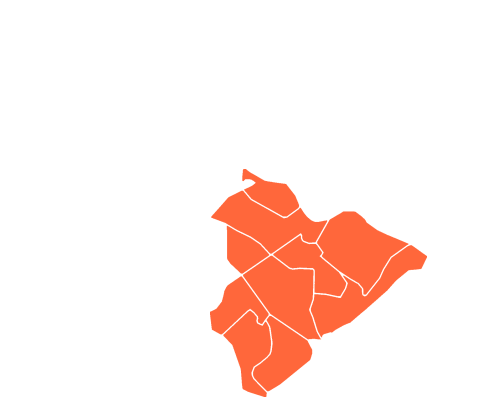










South Carolina hosts much of the suburban and industrial growth surrounding Charlotte – North Carolina’s largest city. Rock Hill and Fort Mill are the major communities on the I-77 corridor in York County just south of the border, offering affordable, attractive bedroom communities both new and old.
Offering more than 40 majors, Winthrop University’s 6,100 students have a wealth of recreational offerings including the Anne Springs Close Greenway, the Catawba River and even a world-class velodrome at the Riverwalk Outdoor Center.
Charlotte itself is an international banking center and the hometown of NASCAR, the NFL’s Carolina Panthers and the NBA’s Charlotte Hornets. Major art and science museums and performance centers grace uptown Charlotte and the city also is home to the unusual attractions such as the National Whitewater Center and Carowinds, a nationally known theme park that sits astride the state line.
York County is at the north end of the 90 miles of I-77 through four counties to the state capital of Columbia. Along the way are Chester and Fairfield counties, with rural landscapes and small towns that provide affordable living and easy access to the economic opportunities developing along the corridor. That includes Giti Tire’s new $560 million plant in Chester County, now ramping up production and expected to add 1,700 new positions in the next decade.
Central South Carolina is known as the Midlands, with the state capitol in Columbia as its center. The metro area of 820,000 people has a resilient economy based on state government, the nation’s largest military basic training post at Fort Jackson, and the 35,000-student flagship campus of the University of South Carolina.
USC is home to the Darla Moore School of Business, regularly ranked among the tops in the nation in international business programs. The USC Honors College is also among the nation’s leaders, and the school is working to keep on the leading edge with programs that include it its McNair Aerospace Center and IBM Technology Incubator.
The school helps fuel a growing software and services scene, including both startups and name brands such as Capgemini, as well as major employers including Blue Cross, Colonial Life and AFLAC. Amazon and UPS have established major presences near Columbia Metropolitan Airport.
Sports in the Midlands is anchored by Williams-Brice Stadium and Colonial Life Arena, home to the Gamecocks football and basketball teams (as well as major concerts), and by Founders Park, the Southeastern Conference school’s iconic baseball stadium. Professionally, there’s also the Fireflies, a Class A affiliate of the New York Mets who play in the brand-new Spirit Communications Park.
There’s a thriving dining, arts, music and shopping scene, miles of riverfront walkways, art and history museums, and Riverbanks Zoo & Garden, the state’s top single visitor attraction. In addition, there’s Congaree National Park, the nation’s largest remaining original riverine bottomlands of its kind.
Upstate South Carolina, home to Greenville and Spartanburg and part of the Blue Ridge foothills, is located along the commerce-rich I-85 corridor between Atlanta and Charlotte.
Driven by BMW coming to South Carolina more than 25 years ago, the Upstate has become an economic powerhouse, where BMW’s assembly plant is the linchpin of an auto supplier network that spans the region.
Greenville’s downtown, which has become a regional dining and shopping hotspot, includes 3,000-student Furman University, 2,800-student Bob Jones University and 2,300-student North Greenville University. The University of South Carolina School of Medicine recently established its second campus in Greenville, and the Governor’s School for the Arts & Humanities attracts some of the state’s top high school students to its two-year residency programs.
Spartanburg’s seven colleges and universities include 1,700-student Wofford College and 6,000-student University of South Carolina-Upstate.
The crown jewel of Upstate education is 23,000-student Clemson University, which has become a major technology, science and agriculture research university. The school is home to the CU International Center for Automotive Research and the nation’s only graduate department of automotive engineering. Clemson also is a longtime leader in advanced fabrics and agricultural research and service.
Along with championship athletics at Clemson, the Upstate offers a wide range of cultural and recreational experiences for people of all ages and where the cost of living is 10% below the national average, Upstate South Carolina is proving a popular destination for new industrial investment, relocation and retirement.
Anchored by Myrtle Beach, the Grand Strand stretches 60 miles from the North Carolina border to the colonial port village of Georgetown, where sandy beaches and sand traps alike attract millions of visitors each year.
With more than 100 golf courses and a diverse selection of beaches, this popular tourist destination spans from iconic Ocean Boulevard in Myrtle Beach to old-timey beach towns to Huntington Beach State Park, where maritime woods and marsh border three miles of wide, sandy beach to form one of the top bird-watching sites on the East Coast.
With 74 undergraduate degree programs plus 21 graduate programs, students at the local Coastal Carolina University enjoy an average annual high of 75 degrees and more than 200 days of sunshine per year.
Plus, local residents, who have access to more than a thousand restaurants and a wide array of entertainment and attractions, have vast housing options ranging from seasonal RV sites to high-end gated communities along the ocean and the Intracoastal Waterway.
Named for the Pee Dee River, inland northeast South Carolina is served by I-95 and is anchored by Florence, the commercial center of vast swaths of surrounding farmland and a gateway to the Grand Strand.
Florence has its own industrial base, and a thriving arts and culture community, the latter joined by the emergence of nearby Lake City, home of shuttle astronaut Ron McNair, as an arts center of its own right.
The largest Pee Dee academic institution is 4,200-student Francis Marion University, which offers 10 graduate and undergraduate degrees at its Florence campus. Hartsville is home to both global packaging products leader Sonoco and to the Governor’s School for Science & Mathematics in picturesque Hartsville.
Tobacco farming towns like Marion and Mullins also add to the charm of this agriculture-dominated area of the state, affordable and charming.
The Pee Dee also is home to one of America’s most iconic auto racing destinations, NASCAR’s Darlington Raceway.
The Lowcountry, home to the internationally renowned destinations of Charleston and Hilton Head Island, is a land of sea islands, marsh and salt creeks, Spanish moss and live oaks and the evocative Gullah culture.
Regularly ranked among the world’s top foodie destinations, Charleston was recently chosen No. 1 in the country for economic opportunity by Yelp.com. That ranking is no surprise, as The Port of Charleston ranks number 6 nationally in terms of dollar value of goods handled, and major employers in the area now include Boeing, Mercedes-Benz and Volvo.
For higher education, a growing software and services scene is fed by graduates from local schools including the 11,600-student College of Charleston, founded in 1770 and offering 137 majors and minors, including the nation’s undergraduate program in data science. There’s also The Citadel, South Carolina’s military college, as well as the Medical University of South Carolina, founded in 1824 and the oldest in the Deep South.
Hilton Head is deemed one of the best-preserved coastal destinations in the world, as residents and tourists alike enjoy 12 miles of beaches, more than 40 golf courses, and high-end shopping and living options cloistered under a canopy of maritime forest. Plus, there’s nearby Beaufort – one of the oldest cities in the state and host to Parris Island and the U.S. Marines.
The Savannah River begins in the mountains and ends in the sea. The valley it forms has a long agricultural and textile history and a string of small cities and towns that offer affordable living and growing economic opportunity.
Within the valley is the Central Savannah River Area, including North Augusta and Aiken, the latter a playground for northern industrialists a century ago who created a continuing equestrian presence that includes international polo tournaments.
Aiken also is home to the 3,500-student University of South Carolina-Aiken, now offering 47 programs in a four-year setting, and to the nearby Savannah River Site, the nuclear weapons complex that gave rise to a large engineering-based, educated workforce.
The Savannah River region is a recreational mecca where residents enjoy a wide array of water sports, hiking and camping activities offered by Lake Thurmond and the Aiken State Park. Golf courses abound, Aiken itself boasts Hitchcock Woods, a 2,100-acre longleaf pine forest right in the city, popular with hikers, dog walkers and horse riders.